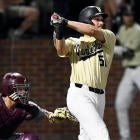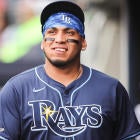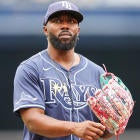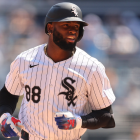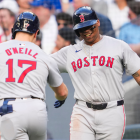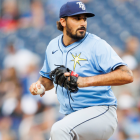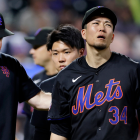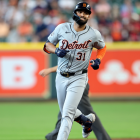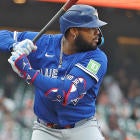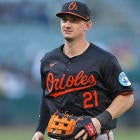June is a good month for those who enjoy watching and speculating about baseball's future. Major League Baseball's first-year player draft wrapped up Wednesday after stealing headlines on both Monday and Tuesday. Next up, on Friday, the NCAA Baseball Tournament will begin Super Regional play. The teams who win their respective best-of-three series will then move on to the College World Series, which will then determine this year's national champion.
Because the draft and college baseball are eternally linked, we decided to put together a handy league-wide guide highlighting one player drafted by each team within the top 10 rounds who remains alive in the NCAA Tournament -- you know, in case you wanted to tune in to some of the action and get a glimpse of who might on your favorite team in a few years' time. In the rare cases where the team hadn't drafted anyone from an active team, we defaulted to the top collegiate player in their class.
Before we get to the players, let's offer a quick refresher on which teams are playing which in the Super Regionals (you can check out the full bracket by clicking here):
LSU vs. Florida State
North Carolina vs. Auburn
Ole Miss vs. Arkansas
Stanford vs. Mississippi State
Texas Tech vs. Oklahoma State
Louisville vs. Eastern Carolina
UCLA vs. Michigan
Vanderbilt vs. Duke
Remember, those teams will engage in a best-of-three series, with each of the eight winners advancing to the College World Series.
Got it? Good, now onto the players.
| The Diamondbacks had a load of early draft picks, so you knew they had to have someone who remained involved in the tournament. That someone is Tommy Henry, the 74th pick and a left-handed starter for Michigan. Henry has a tall, lean frame and the chance for three average or better pitches that he delivers from a high three-quarters release point. Though he imparts good spin on his heater, his velocity is said to have slipped throughout the year. If he can correct that as a professional, he'll have a shot at serving near the back of a big-league rotation. | |
| Because the Braves did not draft anyone from those 16 schools in the first 10 rounds, we're going to focus on their top collegiate pick: Baylor catcher Shea Langeliers, who was the ninth selection overall. Langeliers actually set an NCAA tournament record with 11 runs batted in, but Baylor was eliminated all the same. Amusingly, his calling card is his defense rather than his bat, as he possesses all the traits needed to be an impact-level defender: a big arm, soft hands, agile body, and top-notch leadership skills. There's question as to how much he'll hit, but the defense ought to provide him with a high floor. | |
| Everyone focuses on Adley Rutschman (and rightfully so given he was the No. 1 pick), but the Orioles took a few other successful collegiate hitters in the early going, too. That bunch includes Zach Watson of LSU, Maverick Handley of Stanford, and Handley's teammate -- and our focus here -- outfielder Kyle Stowers. If you like outfielders with well-above-average raw power who take aggressive cuts, then you'll enjoy Stowers. Be careful, though, as there's some risk that he won't make enough contact to make his power count. | |
| Cody Scroggins, the 287th pick in the draft, is a short right-hander with a history of elbow woes and shaky control (he walked more than five per nine this season). He does throw hard, however, and that should come in handy if/when he lands in the bullpen. | |
| We covered Chase Strumpf's remarkable timing a few days ago, but for those who missed out on the story: he homered for UCLA less than two minutes after being picked 64th by the Cubs. His bat will determine if he's to have a big-league career, as he's likely to be limited to second base defensively. | |
| None of Chicago's picks in the first 10 rounds remain active in the tournament. That's fine with us, as it means we can write more about Andrew Vaughn, the Cal first baseman who joined the White Sox as the No. 3 pick in the draft. Vaughn can really hit and receives high marks for his makeup as he transformed himself from an undrafted corner-infield prospect to arguably the best hitter in college baseball in a few years' time. Teams are always wary of right-handed-hitting first basemen, and Vaughn's limited size (6-feet) doesn't help, but he has the chance to be a middle-of-the-order hitter -- and soon. | |
| The Reds are another club who won't have rooting interests in the Super Regionals. As such, we'll touch on TCU left-hander Nick Lodolo, who was the first pitcher taken off the board, at No. 7 overall. Lodolo might remind you of David Price physically, as he's tall and lean and has a similar start to his delivery. Lodolo wasn't as good as Price collegiately, but he could develop into a high-quality starter who has three above-average or better offerings. | |
| Cleveland completes the hat trick of teams without a top-10 round draftee alive in the NCAA tournament. It's not too surprising -- Cleveland didn't draft a collegiate player until its fifth pick, No. 160 overall. That player? Georgia State right-hander Hunter Gaddis, who stands 6-6 and reportedly throws a changeup that sometimes clocks in below 70 mph. That's fun. | |
| The Rockies surprised by taking UCLA first baseman Michael Toglia with the 23rd pick. He's tall and has light-tower power, but -- as is often the case -- there are questions about his ability to make consistent contact in order to maximize his production. | |
| The name to know here is UCLA infielder Ryan Kreidler, who plays shortstop but could wind up at third base due to his size (he's listed at 6-4 by the school). Kreidler tapped into some of his offensive potential this season for the Bruins, homering nine times -- or twice more than he had over his first two seasons on campus. If he can keep hitting, there's starting potential here. | |
| Grae Kessinger, a shortstop at Ole Miss, is an instinctual player with good bloodlines. The Astros have a good track record of getting the most from their players. It'll be interesting to see if they try to unlock more power from Kessinger's 6-2 frame, as he'll finish his career at Ole Miss with a .415 slugging percentage. | |
| The Royals took Florida State left-hander Drew Parrish in the eighth round. He's a small lefty who struck out 112 batters in 81 innings thanks in part to his curveball. | |
| The Angels drafted Auburn right-hander Davis Daniel in the seventh round. He won't be pitching in the Super Regional or anytime soon after undergoing Tommy John surgery in April. | |
| The Dodgers doubled up on collegiate hitters to begin their draft, taking Tulane third baseman Kody Hoese at No. 25 then North Carolina's Michael Busch at 31. Busch was announced as a second baseman, which should be a fun experiment to watch unfold, given he mostly played first base for the Tar Heels. Wherever Busch ends up on the diamond, his best position is likely to be in the batter's box, as he has the chance to be a high-quality hitter in due time. | |
| Vanderbilt outfielder J.J. Bleday was the fourth pick in the draft thanks to his well-rounded game. He has the chance to contribute everywhere, and could move quickly through the system. You might remember him from the MLB Network broadcast as the feller whose tape was reviewed by Ken Griffey Jr . | |
| Milwaukee used its first pick in the draft, No. 28, to take Mississippi State southpaw Ethan Small. The name doesn't match the body, as he's listed at 6-3 and has the profile of a mid-to-back-end starter who gets by on his pitchability and deception more so than his raw stuff. | |
| Will Holland has well-above-average speed and some raw power, yet his physical tools seldom translated into jaw-dropping statistics during his time as Auburn's shortstop. He hit just .248 in 2019 (albeit with a .378 on-base percentage) while striking out in more than a quarter of his at-bats. The Twins popped Holland in the fifth round and will try to unlock his potential. | |
| Mississippi State outfielder Jake Mangum was chosen by the Mets in the fourth round as the start of their run on college seniors. Mangum is a switch-hitting slasher with above-average speed. He finished the season with one home run, which may be enough for him to dodge Jason Tyner comparisons. | |
| Although LSU infielder Josh Smith has the most generic name in the draft, the Yankees liked his game enough to pick him in the second round. He doesn't feature a plus tool, but he does a little bit of everything and that gives him a high floor. | |
| The Athletics stayed in the Carolinas for their first two picks, drafting Clemson infielder Logan Davidson at No. 29 before turning their attention to UNC righty Tyler Baum at 66. Baum is the one still playing, so he's the one who gets the spotlight. He has the chance for three average or better offerings and could slot in near the back of a rotation someday. | |
| The Phillies drafted left-hander Erik Miller out of Stanford with their fourth-round pick. There's a chance that looks pretty, pretty slick in a few years' time, as he has the raw ingredients to be a high-quality starter: size, arm strength, feel for secondaries. There's also a chance the gamble doesn't pay off, as Miller has struggled enough with consistency to be available in the fourth round in the first place. | |
| J.C. Flowers played center field and pitched for Florida State, but the Pirates announced him only as a pitcher when they selected him in the fourth round. He struck out 22 batters in 23 innings as FSU's closer. He's athletic and theoretically could improve as he focuses just on pitching heading forward. | |
| The Padres picked Vanderbilt righty Drake Fellows in Round 6. While his name doubles as a colloquial term for the Toronto Raptors, Fellows could pitch in the majors someday thanks to an average arsenal. | |
| How about two for the price of one? The Giants selected college hitters with three of their first four picks, including Arizona State outfielder Hunter Bishop. We're going to give a little love to a pair of Louisville infielders they picked thereafter: first baseman Logan Wyatt (second rounder) and shortstop Tyler Fitzgerald (fourth rounder). Wyatt projects as an average or better hitter, while Fitzgerald is more well-rounded and could be a great value get if he can tap into his raw power. | |
| Did you know Arkansas right-hander Isaiah Campbell was born in Portugal? That's a fun fact. Campbell, of course, was selected by the Mariners in the competitive balance round for reasons other than his birthplace. He's proven to be healthy after missing his sophomore season, and has exhibited great control: This year he walked just 19 batters in 103 innings -- that's about 1.66 per nine, for those doing the math. Campbell's stuff is average or better as well, meaning he could end up as a No. 3 or 4 starter when all is said and done. | |
| The Cardinals grabbed 6-6 UCLA senior Jack Ralston in the seventh round. The right-handed Ralston has a somewhat unusual delivery (due to his long arm circle) and a somewhat unusual story, as he had made just 14 appearances for the Bruins entering this season -- and no, not because he was injured or otherwise unavailable. Ralston showed enough promise in his 16 starts for the Cardinals to deem him worth the shot. We'll see if it pays off. | |
| You won't see Graeme Stinson pitching for Duke against Vanderbilt. Stinson, a lefty with a high-grade slider, was shut down earlier in the spring due to a hamstring injury. The Rays picked him in the fourth with the hope they can get him healthy and back to his old form -- if so, they could have a steal on their hands. | |
| The Rangers picked Texas Tech third baseman Josh Jung eighth overall. He's a well-rounded prospect who should stick at the hot corner while producing at the plate. There's some question as to whether the Rangers will attempt to tweak his swing in order for him to get the most of his raw power. Either way, he ought to be the Rangers' long-term future at third. | |
| A number of other Vanderbilt players have already been touched on here, but let's add catcher Philip Clarke to the mix. He was Toronto's ninth-round pick thanks to the strength in his bat. | |
| Third-round pick Drew Mendoza was the Nationals' second selection of the class (they sacrificed their second-rounder to sign Patrick Corbin). He has a big frame and big power, which could come in handy whether he sticks at third base or moves to the cold corner. The catch is that his strikeout tendencies make him a legitimate attrition risk. | |







































